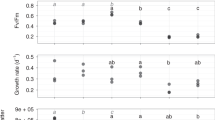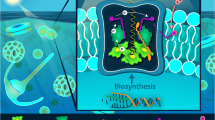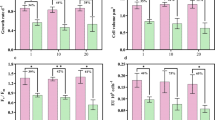Abstract
Marine algae perform approximately half of global carbon fixation, but their growth is often limited by the availability of phosphate or other nutrients1,2. As oceans warm, the area of phosphate-limited surface waters is predicted to increase, resulting in ocean desertification3,4. Understanding the responses of key eukaryotic phytoplankton to nutrient limitation is therefore critical5,6. We used advanced photo-bioreactors to investigate how the widespread marine green alga Micromonas commoda grows under transitions from replete nutrients to chronic phosphate limitation and subsequent relief, analysing photosystem changes and broad cellular responses using proteomics, transcriptomics and biophysical measurements. We find that physiological and protein expression responses previously attributed to stress are critical to supporting stable exponential growth when phosphate is limiting. Unexpectedly, the abundance of most proteins involved in light harvesting does not change, but an ancient light-harvesting-related protein, LHCSR, is induced and dissipates damaging excess absorbed light as heat throughout phosphate limitation. Concurrently, a suite of uncharacterized proteins with narrow phylogenetic distributions increase multifold. Notably, of the proteins that exhibit significant changes, 70% are not differentially expressed at the mRNA transcript level, highlighting the importance of post-transcriptional processes in microbial eukaryotes. Nevertheless, transcript–protein pairs with concordant changes were identified that will enable more robust interpretation of eukaryotic phytoplankton responses in the field from metatranscriptomic studies. Our results show that P-limited Micromonas responds quickly to a fresh pulse of phosphate by rapidly increasing replication, and that the protein network associated with this ability is composed of both conserved and phylogenetically recent proteome systems that promote dynamic phosphate homeostasis. That an ancient mechanism for mitigating light stress is central to sustaining growth during extended phosphate limitation highlights the possibility of interactive effects arising from combined stressors under ocean change, which could reduce the efficacy of algal strategies for optimizing marine photosynthesis.
This is a preview of subscription content, access via your institution
Access options
Access Nature and 54 other Nature Portfolio journals
Get Nature+, our best-value online-access subscription
$29.99 / 30 days
cancel any time
Subscribe to this journal
Receive 12 digital issues and online access to articles
$119.00 per year
only $9.92 per issue
Buy this article
- Purchase on Springer Link
- Instant access to full article PDF
Prices may be subject to local taxes which are calculated during checkout




Similar content being viewed by others
References
Field, C. B., Behrenfeld, M. J., Randerson, J. T. & Falkowski, P. Primary production of the biosphere: integrating terrestrial and oceanic components. Science 281, 237–240 (1998).
Wu, J., Sunda, W., Boyle, E. A. & Karl, D. M. Phosphate depletion in the western North Atlantic. Ocean. Sci. 289, 759–762 (2000).
Behrenfeld, M. J. et al. Climate-driven trends in contemporary ocean productivity. Nature 444, 752–755 (2006).
Flombaum, P. et al. Present and future global distributions of the marine Cyanobacteria Prochlorococcus and Synechococcus. Proc. Natl Acad. Sci. USA 110, 9824–9829 (2013).
Worden, A. Z. et al. Environmental science. Rethinking the marine carbon cycle: factoring in the multifarious lifestyles of microbes. Science 347, 1257594 (2015).
Sebastian, M. et al. Lipid remodelling is a widespread strategy in marine heterotrophic bacteria upon phosphorus deficiency. ISME J. 10, 968–978 (2016).
Worden, A. Z. et al. Green evolution and dynamic adaptations revealed by genomes of the marine picoeukaryotes Micromonas. Science 324, 268–272 (2009).
Monier, A., Worden, A. Z. & Richards, T. A. Phylogenetic diversity and biogeography of the Mamiellophyceae lineage of eukaryotic phytoplankton across the oceans. Environ. Microbiol. Rep. 8, 461–469 (2016).
Clayton, S., Lin, Y.-C., Follows, M. J. & Worden, A. Z. Co‐existence of distinct Ostreococcus ecotypes at an oceanic front. Limnol. Oceanogr. 62, 75–88 (2017).
Limardo, A. J. et al. Quantitative biogeography of picoprasinophytes establishes ecotype distributions and significant contributions to marine phytoplankton. Environ. Microbiol 19, 3219–3234 (2017).
Countway, P. D. & Caron, D. A. Abundance and distribution of Ostreococcus sp. in the San Pedro Channel, California, as revealed by quantitative PCR. Appl. Environ. Microbiol 72, 2496–2506 (2006).
Worden, A. Z., Nolan, J. K. & Palenik, B. Assessing the dynamics and ecology of marine picophytoplankton: the importance of the eukaryotic component. Limnol. Oceanogr. 49, 168–179 (2004).
Simmons, M. P. et al. Intron invasions trace algal speciation and reveal nearly identical Arctic and Antarctic Micromonas populations. Mol. Biol. Evol. 32, 2219–2235 (2015).
Not, F. et al. Late summer community composition and abundance of photosynthetic picoeukaryotes in Norwegian and Barents Seas. Limnol. Oceanogr. 50, 1677–1686 (2005).
Cuvelier, M. L. et al. Targeted metagenomics and ecology of globally important uncultured eukaryotic phytoplankton. Proc. Natl Acad. Sci. USA 107, 14679–14684 (2010).
Treusch, A. H. et al. Phytoplankton distribution patterns in the northwestern Sargasso Sea revealed by small subunit rRNA genes from plastids. ISME J. 6, 481–492 (2012).
Lomas, M. W. et al. Two decades and counting: 24-years of sustained open ocean biogeochemical measurements in the Sargasso Sea. Deep Sea Res. Part II Top. Stud. Oceanogr. 93, 16–32 (2013).
Wurch, L. L., Bertrand, E. M., Saito, M. A., Van Mooy, B. A. & Dyhrman, S. T. Proteome changes driven by phosphorus deficiency and recovery in the brown tide-forming alga Aureococcus anophagefferens. PLoS ONE 6, e28949 (2011).
Hsieh, S. I. et al. The proteome of copper, iron, zinc, and manganese micronutrient deficiency in Chlamydomonas reinhardtii. Mol. Cell Proteom. 12, 65–86 (2013).
Dyhrman, S. T. et al. The transcriptome and proteome of the diatom Thalassiosira pseudonana reveal a diverse phosphorus stress response. PLoS ONE 7, e33768 (2012).
Dyhrman, S. T. et al. Long serial analysis of gene expression for gene discovery and transcriptome profiling in the widespread marine coccolithophore Emiliania huxleyi. Appl. Environ. Microbiol. 72, 252–260 (2006).
Himeoka, Y. & Kaneko, K. Theory for transitions between exponential and stationary phases: universal laws for lag time. Phys. Rev. X 7, 021049 (2017).
Yang, Z. K. et al. Systems-level analysis of the metabolic responses of the diatom Phaeodactylum tricornutum to phosphorus stress. Environ. Microbiol 16, 1793–1807 (2014).
Thompson, A. W., Huang, K., Saito, M. A.. & Chisholm, S. W. Transcriptome response of high- and low-light-adapted Prochlorococcus strains to changing iron availability. ISME J. 5, 1580–1594 (2011).
Grossman, A. R. & Aksoy, M. in Annual Plant Reviews Vol. 48: Phosphorus Metabolism in Plants (eds. Plaxton, W. C. & Lambers, H.) Ch. 12 (Wiley, Hoboken, 2015).
Plaxton, W. C. & Tran, H. T. Metabolic adaptations of phosphate-starved plants. Plant Physiol. 156, 1006–1015 (2011).
Keeling, P. J. et al. The Marine Microbial Eukaryote Transcriptome Sequencing Project (MMETSP): illuminating the functional diversity of eukaryotic life in the oceans through transcriptome sequencing. PLoS Biol. 12, e1001889 (2014).
Cuvelier, M. L. et al. Responses of the picoprasinophyte Micromonas commoda to light and ultraviolet stress. PLoS ONE 12, e0172135 (2017).
Lan, P., Li, W. & Schmidt, W. Complementary proteome and transcriptome profiling in phosphate-deficient Arabidopsis roots reveals multiple levels of gene regulation. Mol. Cell Proteom. 11, 1156–1166 (2012).
Waltman, P. H. et al. Identifying aspects of the post-transcriptional program governing the proteome of the green alga Micromonas pusilla. PLoS ONE 11, e0155839 (2016).
Harvey, R., Dezi, V., Pizzinga, M. & Willis, A. E. Post-transcriptional control of gene expression following stress: the role of RNA-binding proteins. Biochem. Soc. Trans. 45, 1007–1014 (2017).
Monier, A. et al. Phosphate transporters in marine phytoplankton and their viruses: cross-domain commonalities in viral-host gene exchanges. Environ. Microbiol. 14, 162–176 (2012).
Le Bihan, T. et al. Shotgun proteomic analysis of the unicellular alga Ostreococcus tauri. J. Proteom. 74, 2060–2070 (2011).
Halsey, K. H., Milligan, A. J. & Behrenfeld, M. J. Contrasting strategies of photosynthetic energy utilization drive lifestyle strategies in ecologically important picoeukaryotes. Metabolites 4, 260–280 (2014).
Bender, S. J., Durkin, C. A., Berthiaume, C. T., Morales, R. L. & Armbrust, E. V. Transcriptional responses of three model diatoms to nitrate limitation of growth. Front. Marine Sci. https://doi.org/10.3389/fmars.2014.00003 (2014).
Lommer, M. et al. Genome and low-iron response of an oceanic diatom adapted to chronic iron limitation. Genome Biol. 13, R66 (2012) .
Parkhill, J. P., Maillet, G. & Cullen, J. J. Fluorescence-based maximum quantum yield for PSII as a diagnostic of nutrient stress. J. Phycol. 37, 517–529 (2001).
Kromdijk, J. et al. Improving photosynthesis and crop productivity by accelerating recovery from photoprotection. Science 354, 857–861 (2016).
Peers, G. et al. An ancient light-harvesting protein is critical for the regulation of algal photosynthesis. Nature 462, 518–521 (2009).
Lepetit, B. et al. The diatom Phaeodactylum tricornutum adjusts NPQ capacity in response to dynamic light via fine-tuned Lhcx and xanthophyll cycle pigment synthesis. New Phytol. 214, 205–218 (2016).
Goss, R. & Lepetit, B. Biodiversity of NPQ. J. Plant Physiol. 172, 13–32 (2015).
Maat, D. S., Crawfurd, K. J., Timmermans, K. R. & Brussaard, C. P. Elevated CO2 and phosphate limitation favor Micromonas pusilla through stimulated growth and reduced viral impact. Appl. Environ. Microbiol 80, 3119–3127 (2014).
Moseley, J. L., Chang, C. W. & Grossman, A. R. Genome-based approaches to understanding phosphorus deprivation responses and PSR1 control in Chlamydomonas reinhardtii. Eukaryot. Cell 5, 26–44 (2006).
Smriga, S., Fernandez, V. I., Mitchell, J. G. & Stocker, R. Chemotaxis toward phytoplankton drives organic matter partitioning among marine bacteria. Proc. Natl Acad. Sci. USA 113, 1576–1581 (2016).
Li, W. K. W., McLaughlin, F. A., Lovejoy, C. & Carmack, E. C. Smallest algae thrive as the Arctic Ocean freshens. Science 326, 539 (2009).
Wilson, S. T. et al. Hydrogen cycling by the unicellular marine diazotroph Crocosphaera watsonii strain WH8501. Appl. Environ. Microbiol 76, 6797–6803 (2010).
Porter, K. & Feig, Y. S. The use of DAPI for identifying and counting aquatic microflora. Limnol. Oceanogr. 25, 943–948 (1980).
Murphy, J. & Riley, J. P. A modified single solution method for the determination of phosphate in natural waters. Anal. Chim. Acta 27, 31–36 (1962).
Pennington, J. T. & Chavez, F. P. Seasonal fluctuations of temperature, salinity, nitrate, chlorophyll and primary production at station H3/M1 over 1989–1996 in Monterey Bay, California. Deep Sea Res. Part II 47, 947–974 (2000).
Van Heukelem, L. & Thomas, C. S. Computer-assisted high-performance liquid chromatography method development with applications to the isolation and analysis of phytoplankton pigments. J. Chromatogr. A 910, 31–49 (2001).
Anderson, R. Algal Culturing Techniques (Elsevier, New York, 2005).
McCarthy, J. J. in Physiological Bases of Phytoplankton Ecology (ed. Platt, T.) 211–233 (Canadian Bulletin of Fisheries and Aquatic Sciences, 1981).
McCarthy, J. J. & Goldman, J. C. Nitrogenous nutrition of marine phytoplankton in nutrient-depleted waters. Science 203, 670–672 (1979).
Keller, M. D., Selvin, R. C., Claus, W. & Guillard, R. R. L. Media for the culturing of oceanic ultraplankton. J. Phycol. 23, 633 (1987).
Callister, S. J. et al. Analysis of biostimulated microbial communities from two field experiments reveals temporal and spatial differences in proteome profiles. Environ. Sci. Technol. 44, 8897–8903 (2010).
Fic, E., Kedracka-Krok, S., Jankowska, U., Pirog, A. & Dziedzicka-Wasylewska, M. Comparison of protein precipitation methods for various rat brain structures prior to proteomic analysis. Electrophoresis 31, 3573–3579 (2010).
Lipton, M. S. et al. Global analysis of the Deinococcus radiodurans proteome by using accurate mass tags. Proc. Natl Acad. Sci. USA 99, 11049–11054 (2002).
Robidart, J. et al. Characterizing microbial community and geochemical dynamics at hydrothermal vents using osmotically driven continuous fluid samplers. Environ. Sci. Technol. 47, 4399–4407 (2013).
Kelly, R. T. et al. Chemically etched open tubular and monolithic emitters for nanoelectrospray ionization mass spectrometry. Anal. Chem. 78, 7796–7801 (2006).
Crowell, K. L. et al. LC-IMS-MS feature finder: detecting multidimensional liquid chromatography, ion mobility and mass spectrometry features in complex datasets. Bioinformatics 29, 2804–2805 (2013).
Monroe, M. E. et al. VIPER: an advanced software package to support high-throughput LC-MS peptide identification. Bioinformatics 23, 2021–2023 (2007).
van Baren, M. J. et al. Evidence-based green algal genomics reveals marine diversity and ancestral characteristics of land plants. BMC Genomics 17, 267 (2016).
Stanley, J. R. et al. A statistical method for assessing peptide identification confidence in accurate mass and time tag proteomics. Anal. Chem. 83, 6135–6140 (2011).
Polpitiya, A. D. et al. DAnTE: a statistical tool for quantitative analysis of -omics data. Bioinformatics 24, 1556–1558 (2008).
Callister, S. J. et al. Normalization approaches for removing systematic biases associated with mass spectrometry and label-free proteomics. J. Proteome Res. 5, 277–286 (2006).
Duanmu, D. et al. Marine algae and land plants share conserved phytochrome signaling systems. Proc. Natl Acad. Sci. USA 111, 15827–15832 (2014).
Trapnell, C., Pachter, L. & Salzberg, S. L. TopHat: discovering splice junctions with RNA-Seq. Bioinformatics 25, 1105–1111 (2009).
Trapnell, C. et al. Differential gene and transcript expression analysis of RNA-seq experiments with TopHat and Cufflinks. Nat. Protoc. 7, 562–578 (2012).
Kelley, L. A., Mezulis, S., Yates, C. M., Wass, M. N. & Sternberg, M. J. The Phyre2 web portal for protein modeling, prediction and analysis. Nat. Protoc. 10, 845–858 (2015).
Bun-Ya, M., Nishimura, M., Harashima, S. & Oshima, Y. The PH084 gene of Saccharomyces cerevisiae encodes an inorganic phosphate transporter. Mol. Cell. Biol. 11, 3229–3238 (1991).
Rubin, G. M. Three forms of the 5.8-S ribosomal RNA species in Saccharomyces cerevisiae. Eur. J. Biochem. 41, 197–202 (1974).
Bailleul, B. et al. An atypical member of the light-harvesting complex stress-related protein family modulates diatom responses to light. Proc. Natl Acad. Sci. USA 107, 18214–18219 (2010).
Katoh, K., Kuma, K., Toh, H. & Miyata, T. MAFFT version 5: improvement in accuracy of multiple sequence alignment. Nucleic Acids Res. 33, 511–518 (2005).
Neilson, J. A. D., Rangsrikitphoti, P. & Durnford, D. G. Evolution and regulation of Bigelowiella natans light-harvesting antenna system. J. Plant Physiol. 217, 68–76 (2017).
Stamatakis, A. RAxML version 8: a tool for phylogenetic analysis and post-analysis of large phylogenies. Bioinformatics 30, 1312–1313 (2014).
Burki, F., Shalchian-Tabrizi, K. & Pawlowski, J. Phylogenomics reveals a new ‘megagroup’ including most photosynthetic eukaryotes. Biol. Lett. 4, 366–369 (2008).
Acknowledgements
We thank D. Au, L. Bird, Z. Kolber, R. Thompson and S. Tozzi for contributions to photo-bioreactor design, construction and refinement. We thank M. Ares, K. Halsey, K. Hoadley and J. Barry for helpful discussions and S. Sudek for data deposition. Proteomics was performed at EMSL, a PNNL facility sponsored by DOE’s Office of Biological and Environmental Research. This research was supported by the Packard Foundation, Gordon and Betty Moore Foundation Award GBMF3788 (A.Z.W.), National Science Foundation NSF-IOS0843119 (A.Z.W. and U.G.) and US Department of Energy DOE-DE-SC0004765 (A.Z.W., S.J.C. and R.D.S.).
Author information
Authors and Affiliations
Contributions
A.Z.W., E.N.R., J.G. and V.J. designed the experiments, E.N.R., J.G. and V.J. performed the experiments, flow cytometry and nutrient measurements with contributions from L.S. and V.A.E. S.W. performed NPQ and pigment analyses. C.K.A., S.O.P., R.D.S., S.J.C. performed proteomic analyses and J.G. and S.J.C. further analysed proteomics data with input from A.Z.W. R.D., G.K-R. and C-L.W. performed RNA-seq. R.D. and V.J. analysed RNA-seq with input from A.Z.W. and U.G., C.J.C. performed protein taxonomic distribution studies, C.B. performed phylogenetic analysis and T.A.R. and D.S.M. performed yeast complementation. D.K. was responsible for all technical aspects of the photo-bioreactors. J.G., S.W., U.G. and A.Z.W. wrote the manuscript and all authors read or edited the manuscript.
Corresponding author
Ethics declarations
Competing interests
The authors declare no competing interests.
Additional information
Publisher’s note: Springer Nature remains neutral with regard to jurisdictional claims in published maps and institutional affiliations.
Supplementary information
Supplementary Information
Supplementary Figures 1–13 and Supplementary Figure References.
Supplementary Data 1
P values associated with various tests.
Supplementary Data 2
(A) Proteins that changed (Q < 0.05) or (B) exhibited significant fold changes (Q < 0.05, fold change ≥2) in relative abundance between phases, as computed from average protein abundances from biological duplicates (technical triplicate) over sampled time points. (C) Presence of UP cluster proteins exhibiting ≥3 fold change (Q < 0.05) and lacking known domains, in other taxa, and those ≥2 fold change. (D) MMETSP organisms and peptide files analysed.
Supplementary Data 3
Fold changes of transcripts and protein pairs with significant changes (significance as specified in file) between the PLIMITED and PREPLETE phases. (B) Concordant transcript protein pairs from P-bioreactor experiment and corresponding transcript fold change under N deprivation.
Rights and permissions
About this article
Cite this article
Guo, J., Wilken, S., Jimenez, V. et al. Specialized proteomic responses and an ancient photoprotection mechanism sustain marine green algal growth during phosphate limitation. Nat Microbiol 3, 781–790 (2018). https://doi.org/10.1038/s41564-018-0178-7
Received:
Accepted:
Published:
Issue Date:
DOI: https://doi.org/10.1038/s41564-018-0178-7
This article is cited by
-
Bacterial transcriptional response to labile exometabolites from photosynthetic picoeukaryote Micromonas commoda
ISME Communications (2023)
-
Viruses infecting a warm water picoeukaryote shed light on spatial co-occurrence dynamics of marine viruses and their hosts
The ISME Journal (2021)
-
Metabolic and biogeochemical consequences of viral infection in aquatic ecosystems
Nature Reviews Microbiology (2020)
-
Molecular profiling of an oleaginous trebouxiophycean alga Parachlorella kessleri subjected to nutrient deprivation for enhanced biofuel production
Biotechnology for Biofuels (2019)
-
Diel transcriptional response of a California Current plankton microbiome to light, low iron, and enduring viral infection
The ISME Journal (2019)



